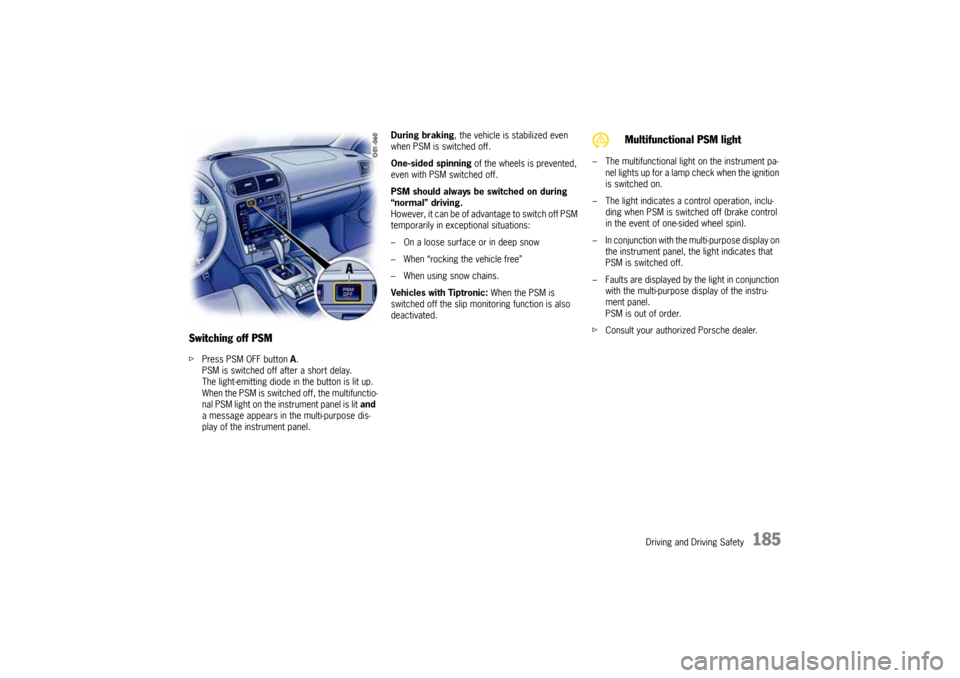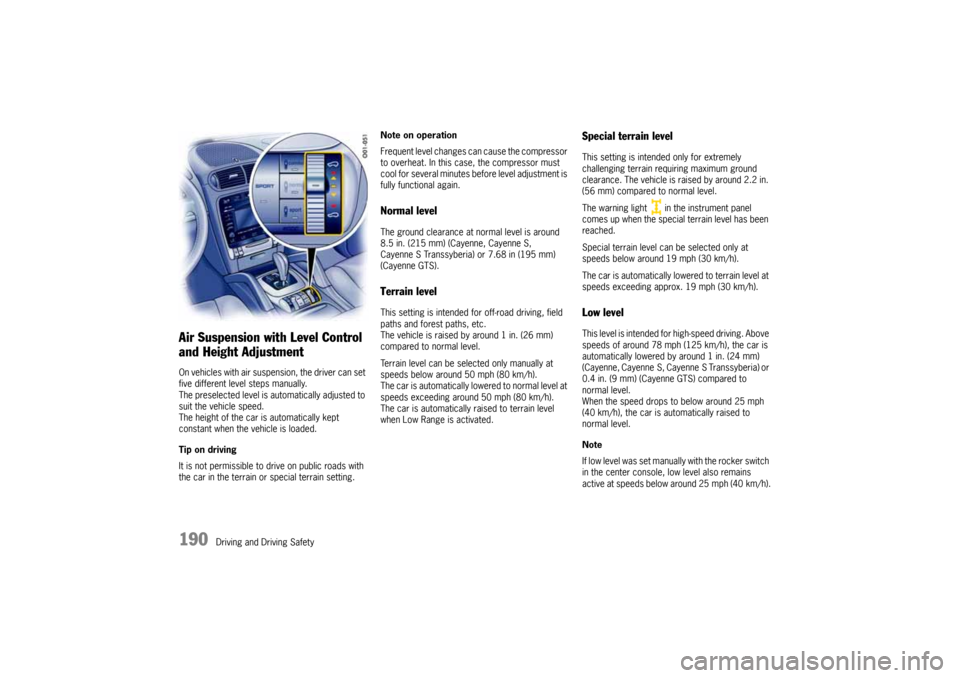PORSCHE CAYNNE 2004 1.G Owners Manual
Manufacturer: PORSCHE, Model Year: 2004, Model line: CAYENNE, Model: PORSCHE CAYENNE 2004 1.GPages: 379, PDF Size: 13.91 MB
Page 181 of 379

Driving and Driving Safety
181
Power-Transmission and Running-Gear Control SystemsA complex interconnection of all control systems acting in power transmission and in the running gear has been realized in your Porsche.
All control systems have been linked with the aim of combining the best possible driving performance with maximum safety.
The following systems are involved:
System/designation Scope
PTM
Porsche Traction Management– Full-time all-wheel drive
– Electronically controlled center differential lock
– Automatic brake differential (ABD)
– Traction control system (TCS)
– Reduction gear/Low Range
PTM Plus
Porsche Traction ManagementIn addition to the PTM features, PTM Plus also includes:
– Electronically controlled rear differential lock
PSM
Porsche Stability Management– Stability management system
– Anti-lock brake system (ABS)
– Brake system prefilling
– Brake booster
– Traction control system (TCS)
– Automatic brake differential (ABD)
– Engine drag torque control (MSR)
Air suspension
with level control and height adjustment– Fully load bearing air spring struts with integral shock absorbers
– Air supply system with pressure accumulator
PAS M
Porsche Active Suspension Management– Shock absorber system with adaptive, continuous shock absorber control
PDCC
Porsche Dynamic Chassis Control– Active chassis control system to stabilize roll tendency of vehicle body when driving
10_Cayenne_21_KW17.book Seite 181 Donnerstag, 9. April 2009 3:33 15
Page 182 of 379

182
Driving and Driving Safety
Warning!
In spite of the advantages of PTM or four-wheel dri-
ve, it is still the driver’s responsibility to adapt her/
his driving style and maneuvers in line with road
and weather conditions, as well as the traffic situ-
ation.
The increased safety that is provided should not
induce you to take greater risks with your safety.
The limits set by the physics of driving cannot be
overcome, even with PTM or four-wheel drive.
Risks of accident due to inappropriate speed
cannot be reduced by PTM.Porsche Traction Management (PTM)Porsche Traction Management is a full-time all-
wheel control system designed to influence the
longitudinal and lateral dynamics. It is closely
linked with the Porsche Stability Management
(PSM) system:
PTM ensures the best possible power distribution
to the four driven wheels at the front and rear
axles. The system realizes this optimal traction by
intervening in the lock control function of the trans-
fer case and rear differential. PTM is active at all
times and, unlike the PSM, cannot be switched off.Advantages of PTM
– Obvious improvement in traction, driving
stability and steering ability of the car.
– Vehicle is more manageable when driven at its
performance limits.
– Improved straight-ahead tracking and stability.
– The aforementioned features allow for a
sportier setup of the running gear.
– The TCS and ABD provide even better traction
for all wheels.
Full-time all-wheel drive
With the four-wheel drive, the drive power is
variably distributed to the front and rear wheels.
Power distribution and wheel speed compensation
between the front and rear axles is realized with a
transfer box.
Distribution of the drive power depends on the
wheel speed difference between the two axles.
The transfer box always controls power distribu-
tion in such a way that optimal propulsion is achie-
ved, even on an unfavorable road surface.
Full-time four-wheel drive ensures optimal handling
and greater stability.Automatic brake differential (ABD)
The ABD system controls the front and rear axles
separately. If one wheel of an axle starts to spin,
it is braked so that the other wheel on the same
axle can be driven.
The ABD recognizes different driving states, and it
features control strategies adapted to these
states. In situations in which little propulsive power
is required, such as when the car moves off on a
level gravel surface, traction control already
becomes active at low engine speeds. If great
propulsive power is required, e.g. when moving off
on an uphill slope or for rapid acceleration, the
ABD is adapted accordingly.
A special off-road program is used in Low Range
mode.
Traction control system (TCS)
The traction control system prevents the wheels
from spinning by adjusting the engine power,
thereby ensuring good lane-holding ability and a
stable driving behavior.10_Cayenne_21_KW17.book Seite 182 Donnerstag, 9. April 2009 3:33 15
Page 183 of 379

Driving and Driving Safety
183
Porsche Stability Management (PSM)PSM is an active control system for stabilization of
the vehicle during extreme driving maneuvers. It
operates together with the Porsche Traction
Management (PTM) system.
PSM makes use of both the ABD and TCS
systems, as well as the known functions of the
anti-lock brake system (ABS) and engine drag
torque control system (MSR).
Warning!
In spite of the advantages of PSM, it is still the
driver’s responsibility to adapt her/his driving style
and maneuvers in line with road and weather
conditions, as well as the traffic situation.
The increased safety that is provided should not
induce you to take greater risks with your safety.
The limits set by the physics of driving cannot be
overcome, even with PSM.
Risks of accident due to inappropriate speed
cannot be reduced by PSM.Advantages of PSM
– Best possible traction and lane-holding ability
in all driving situations – even on road surfaces
with varying friction.
– The system compensates for undesired vehi-
cle reactions (load-alteration effect) when the
driver releases the accelerator pedal or brakes
on bends. This compensation functions up to
the maximum lateral acceleration.
– PSM actively stabilizes the vehicle as required
during dynamic driving maneuvers (e.g. rapid
steering movements, during lane changes or
on alternating bends).
– Improved braking stability on corners and on
different or varying road surfaces.
– Improved brake functioning and reduced
stopping distance in the event of emergency
braking.Readiness for operation
PSM is switched on automatically every time you
start the engine.
Function
Sensors at the wheels, brakes, steering system
and engine continuously measure:
– Driving speed
– Direction of travel (steering angle)
– Lateral acceleration
– Longitudinal acceleration
– Rate of turn about the vertical axis
PSM uses these values to determine the direction
of travel desired by the driver.
PSM intervenes and corrects the course if the
actual direction of motion deviates from the
desired course (steering-wheel position):
It brakes individual wheels as needed. If neces-
sary, PSM additionally influences the engine power
or the gear-changing characteristic of the
Tiptronic in order to stabilize the vehicle.
10_Cayenne_21_KW17.book Seite 183 Donnerstag, 9. April 2009 3:33 15
Page 184 of 379

184
Driving and Driving Safety The events below inform the driver of PSM control
operations and warn him to adapt her/his driving
style to the road conditions:
– The multi-functional information light in the
instrument panel lights up.
– Light in the PSM Off button flashes.
– Hydraulic noises can be heard.
– The vehicle decelerates and steering-wheel
forces are altered as the PSM controls the
brakes.
– Reduced engine power.
– The brake pedal pulsates and its position is
changed during braking.
In order to achieve full vehicle deceleration,
foot pressure must be increased after begin-
ning of the brake pedal pulsing.
Examples of PSM control operations
– If the front wheels of the vehicle drift on a
corner, engine power is reduced and the rear
wheel on the inside of the corner is braked if
necessary.
– If the rear of the vehicle swings out on a
corner, the front wheel on the outside of the
corner is braked.– Brake system prefilling:
The brake system is prepared for possible sub-
sequent emergency braking if the accelerator
pedal is released suddenly and quickly.
The brake system is prefilled and the brake
pads are already applied gently to the brake
discs.
– Brake booster:
In the event of an emergency braking operation
where the pedal force is insufficient, a brake
booster provides the braking pressure neces-
sary for maximum deceleration at all 4 wheels.
Combined use of PSM and PTM/PTM Plus
In order to ensure optimal stabilization of the ve-
hicle, the center differential lock (PTM) and possib-
ly the rear differential lock (PTM Plus) are also
opened when PSM interventions occur.
Tip on driving
When PSM is switched off, wheel-specific brake in-
terventions and the traction control system (TCS)
are also inactive.
The automatic brake differential (ABD) remains on.Off-road PSM
(PSM in Low Range program)
When Low Range is active, an off-road PSM
specially matched to off-road driving is activated
to enhance traction.
In order to improve driveability on difficult terrain,
the response of the off-road PSM is less sensitive
in the low speed range when the vehicle is opera-
ted in the Low Range off-road driving program.
If the brakes are highly stressed, the automatic
brake differential (ABD) switches itself off to
protect the brakes. It remains deactivated until the
brake system has cooled sufficiently.
Engine drag torque control
In conditions of excessive slip, the engine drag
torque control system prevents all driven wheels
from locking up when the car is passing. This is
also the case for downshifts on a slippery road.
10_Cayenne_21_KW17.book Seite 184 Donnerstag, 9. April 2009 3:33 15
Page 185 of 379

Driving and Driving Safety
185
Switching off PSMfPress PSM OFF button A.
PSM is switched off after a short delay.
The light-emitting diode in the button is lit up.
When the PSM is switched off, the multifunctio-
nal PSM light on the instrument panel is lit and
a message appears in the multi-purpose dis-
play of the instrument panel.During braking, the vehicle is stabilized even
when PSM is switched off.
One-sided spinning of the wheels is prevented,
even with PSM switched off.
PSM should always be switched on during
“normal” driving.
However, it can be of advantage to switch off PSM
temporarily in exceptional situations:
– On a loose surface or in deep snow
– When “rocking the vehicle free”
– When using snow chains.
Vehicles with Tiptronic: When the PSM is
switched off the slip monitoring function is also
deactivated.– The multifunctional light on the instrument pa-
nel lights up for a lamp check when the ignition
is switched on.
– The light indicates a control operation, inclu-
ding when PSM is switched off (brake control
in the event of one-sided wheel spin).
– In conjunction with the multi-purpose display on
the instrument panel, the light indicates that
PSM is switched off.
– Faults are displayed by the light in conjunction
with the multi-purpose display of the instru-
ment panel.
PSM is out of order.
fConsult your authorized Porsche dealer.
Multifunctional PSM light
10_Cayenne_21_KW17.book Seite 185 Donnerstag, 9. April 2009 3:33 15
Page 186 of 379

186
Driving and Driving Safety Collapsible spare wheel
fNever switch the PSM off when driving with a
collapsible spare wheel.
To w i n g
fFor information on towing:
Please see the chapter “TOWING” on
Page 342.
Tip on driving
When PSM is switched off, wheel-specific brake
interventions and the traction control system
(TCS) are also inactive.
The automatic brake differential (ABD) remains on.
Switching PSM back onfPress PSM OFF button A.
PSM is switched on after a short delay.
The light-emitting diode in the button and the
multi-functional PSM light on the instrument
panel go out. A message is shown on the multi-
purpose display of the instrument panel.
ABS
(Anti-lock Brake System)
Warning!
In spite of the advantages of ABS, it is still the
driver’s responsibility to adapt her/his driving style
and maneuvers in line with road and weather
conditions, as well as the traffic situation.
The increased safety that is provided should not
induce you to take greater risks with your safety.
The limits set by the physics of driving cannot be
overcome, even with ABS.
Risks of accident due to inappropriate speed can-
not be reduced by ABS.
ABS ensures:
–Full steering control
The vehicle remains steerable
–Good driving stability
No skidding due to locked wheels
–Optimum braking distance
Shorter stopping distances in most cases
–Lock prevention
No flat spots on the tiresFunction
The decisive advantage of ABS is in the driving
stability and maneuvrability of the vehicle in
hazardous situations.
ABS prevents locking of the wheels during full
braking, on almost all road surfaces, until shortly
before the vehicle stops.
The ABS begins to control the braking process as
soon as a wheel shows a tendency to lock.
This controlled braking process is comparable to
extremely rapid cadence braking.
The pulsating brake pedal and a “rattling noise”
warn the driver to adapt her/his driving speed to
the road conditions.
fIf full braking should be necessary, press the
brake pedal all the way down throughout the
entire braking procedure, regardless of the
pulsating pedal. Do not ease up on pressure
applied to the pedal.
10_Cayenne_21_KW17.book Seite 186 Donnerstag, 9. April 2009 3:33 15
Page 187 of 379

Driving and Driving Safety
187
Warning light
If the ABS warning lights light up in the instrument
panel and on the multi-purpose display of the
instrument panel while the engine is running, the
ABS has switched off because of a fault.
In this event, the braking system will operate with-
out lock prevention,as in cars without ABS.
fAdapt your driving style to the changed
braking behavior.
fThe ABS must be checked immediately at an
authorized Porsche dealer. This is necessary
in order to prevent the occurrence of further
faults whose effects cannot be defined.
The ABS control unit is adjusted for the approved
tire dimensions.
The use of tires with non-approved dimensions can
lead to different wheel speeds, causing the ABS to
switch off.
Off-road ABS
(ABS in Low Range program)
When Low Range is active, an ABS specially
matched to off-road driving is activated automati-
cally.In the event of braking on loose ground, the per-
missible slip values for ABS braking are increased
so that the off-road braking distance is reduced
(wheels dig into the surface).
If the driver needs to steer, this off-road driving
program is automatically switched off to maintain
steerability.
Hillholder -
moving-off assistant on vehicles with
Tiptronic SIn Tiptronic selector lever positions D and M, the
hillholder function makes it easier to move off
from a standstill on an upward slope when the
engine is running. The driver does not have to
apply the brake.
The hillholder thus makes moving off on slopes
easier.
Danger!
Risk of accident, resulting in serious perso-
nal injury or death.
The vehicle can roll backwards if the Hillhol-
der is switched off.
fAlways apply the footbrake on slopes.Hillholder is not active:
– In Tiptronic selector lever positions N and R
– In the limp-home mode and
– If not all of the wheels are touching the ground
(on difficult terrain, for example).
Warning!
In spite of the advantages of the hillholder func-
tion, it is still the driver’s responsibility to adapt
her/his driving style and maneuvers in line with
situational conditions.
The increased safety that is provided should not
induce you to take greater risks with your safety.
The limits set by the physics of driving cannot be
overcome, even with the hillholder function.
Driving at the limits should be avoided, e.g., on icy
slopes or on slippery surfaces. In this and similar
cases, the support of the hillholder function is not
guaranteed.
10_Cayenne_21_KW17.book Seite 187 Donnerstag, 9. April 2009 3:33 15
Page 188 of 379

188
Driving and Driving Safety
Porsche Drive-Off Assistant –
Moving-off assistant on vehicles with
manual transmissionThe Porsche Drive-Off Assistant enables the driver
to move off on upward slopes. The vehicle must
have sufficient road contact to use this feature.
The Porsche Drive-Off Assistant is available for
slopes starting at approximately 5%.
fPlease see the chapter “TRAILER COUPLING”
on Page 230.
Danger!
Risk of accident, resulting in serious perso-
nal injury or death.
When moving off on a slippery surface (e.g.,
on icy or loose surfaces), assistance by the
Porsche Drive-Off Assistant is no longer
assured. In this case, the vehicle could slip.
The limits set by the physics of driving cannot
be overcome, even with the Porsche Drive-
Off Assistant. The responsibility for moving
off on upward slopes is still the driver's,
despite the Porsche Drive-Off Assistant.
fAlways adjust your driving style to the driving
conditions and vehicle load, use the footbrake if necessary.Moving off with Porsche Drive-Off Assistant
1. Hold the vehicle securely with footbrake or
parking brake on the slope.
The engine must be running.
2. Fully depress the clutch pedal.
3. Engage one of the gears used to ascend in the
direction of travel (1st gear or reverse).
4. While keeping the clutch pedal depressed,
release the footbrake or foot-operated parking
brake.
The vehicle is held on the slope.
5. Move off as usual.Note on operation
The Porsche Drive-Off Assistant ceases to func-
tion:
– By shifting to neutral.
– When changing gears.
– If the engine is not running.
Danger!
Risk of accident, resulting in serious perso-
nal injury or death.
If the Porsche Drive-Off Assistant ceases to
function, the vehicle will no longer be held on
a slope.
fHold the vehicle with the footbrake.
10_Cayenne_21_KW17.book Seite 188 Donnerstag, 9. April 2009 3:33 15
Page 189 of 379

Driving and Driving Safety
189
Engine Braking Support
(Assistance when heading downhill)The Porsche Down-Hill Assistant is an assistance
system which helps the driver at slower downhill
driving up to approx. 12 mph (20 km/h), e.g., on
steep slopes or on wintry mountain roads.
As long as the gas pedal is not used when
traveling downhill, the Porsche Down-Hill Assistant
is active and brakes the vehicle.
If road grip is lost on one or more wheels, the
system brakes the wheels which have good road
contact.
The braking ability of the Engine Braking Support
is affected by slippery surfaces (e.g., on icy or
loose surfaces), like all brakes.
Warning!
Risk of accident, resulting in serious perso-
nal injury or death. Reduced braking ability
on a slippery surface.
fAlways adjust your driving style to the driving situation.
Conditions:
– The gas pedal must not be used when
travelling downhill.
– The speed must not exceed 12 mph
(20 km/h).–Vehicles with Tiptronic S:
The Tiptronic selector lever position D, M or R
must be engaged.
–Vehicles with manual transmission:
The reverse gear or any other gear (1. - 6. )
must be engaged. The clutch pedal must not
be used when travelling downhill.
Tip on driving
The Porsche Down-Hill Assistant is active when
driving downhill either forwards or backwards.
Checks on test standsBrake tests
Brake tests must be carried out only in High Range
and on plate-type test stands or roller test stands.
The following limit values must not be exceeded
on roller test stands:
– Testing speed 4.7 mph (7.5 km/h)
– Test duration 20 seconds
Parking brake test
Parking brake tests on the brake tester must be
performed only with the ignition switched off and
the Tiptronic selector lever in position N or the
gearshift lever in neutral.Balancing wheels on the vehicle
During finish balancing of the wheels, the entire
vehicle must be lifted and the wheels must be free
to turn.
Dynamometer testing procedure Some U.S. states and Canadian provinces con-
duct emissions inspection/maintenance testing
involving the use of two-wheel dynamometer.
A two-wheeled dynamometer is a treadmill type
device upon which a single axle of the car, the dri-
ving axle of the vehicle, rotates to simulate vehicle
operation on the road while the vehicle remains
stationary.
Your Porsche Cayenne has a full-time four-wheel
drive system which cannot be disabled. Severe
d a m a g e t o t h e p o w e r t r a i n c a n re s u l t i f t e s t e d o n a
two-wheel dynamometer.
Warning!
To avoid severe powertrain damage and a
possible unexpected movement of the vehic-
le.
fYour Porsche Cayenne vehicle must never be
tested on a two-wheel dynamometer.
fAdvise the emission station of this warning before testing the vehicle.
10_Cayenne_21_KW17.book Seite 189 Donnerstag, 9. April 2009 3:33 15
Page 190 of 379

190
Driving and Driving Safety
Air Suspension with Level Control
and Height AdjustmentOn vehicles with air suspension, the driver can set
five different level steps manually.
The preselected level is automatically adjusted to
suit the vehicle speed.
The height of the car is automatically kept
constant when the vehicle is loaded.
Tip on driving
It is not permissible to drive on public roads with
the car in the terrain or special terrain setting.Note on operation
Frequent level changes can cause the compressor
to overheat. In this case, the compressor must
cool for several minutes before level adjustment is
fully functional again.
Normal levelThe ground clearance at normal level is around
8.5 in. (215 mm) (Cayenne, Cayenne S,
Cayenne S Transsyberia) or 7.68 in (195 mm)
(Cayenne GTS).Terrain levelThis setting is intended for off-road driving, field
paths and forest paths, etc.
The vehicle is raised by around 1 in. (26 mm)
compared to normal level.
Terrain level can be selected only manually at
speeds below around 50 mph (80 km/h).
The car is automatically lowered to normal level at
speeds exceeding around 50 mph (80 km/h).
The car is automatically raised to terrain level
when Low Range is activated.
Special terrain levelThis setting is intended only for extremely
challenging terrain requiring maximum ground
clearance. The vehicle is raised by around 2.2 in.
(56 mm) compared to normal level.
The warning light in the instrument panel
comes up when the special terrain level has been
reached.
Special terrain level can be selected only at
speeds below around 19 mph (30 km/h).
The car is automatically lowered to terrain level at
speeds exceeding approx. 19 mph (30 km/h).Low levelThis level is intended for high-speed driving. Above
speeds of around 78 mph (125 km/h), the car is
automatically lowered by around 1 in. (24 mm)
(Cayenne, Cayenne S, Cayenne S Transsyberia) or
0.4 in. (9 mm) (Cayenne GTS) compared to
normal level.
When the speed drops to below around 25 mph
(40 km/h), the car is automatically raised to
normal level.
Note
If low level was set manually with the rocker switch
in the center console, low level also remains
active at speeds below around 25 mph (40 km/h).
10_Cayenne_21_KW17.book Seite 190 Donnerstag, 9. April 2009 3:33 15